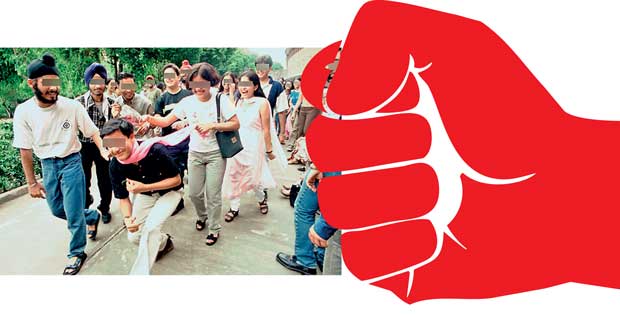Reply To:
Name - Reply Comment

 Ragging is back in the news.
Ragging is back in the news.
Several articles have appeared recently, including one by columnist Ranga Jayasuriya who wrote about his own experiences as a rag victim at university.
His experience vis-a-vis a Vice Chancellor rang a bell as I recalled, what a friend told me some time back.
As someone who graduated with a geology degree from the University of Peradeniya in the 1980s, he told me that the worst raggers usually became Vice-Chancellors. No wonder this epidemic continues to rage with increasing virulence not just in our universities but in almost all state-run institutions of learning, as well as many schools.
Several deaths have been caused by this, some by suicide and others just plain murder.
A first year Tamil engineering student died at the University of Peradeniya after being forced to do hundreds of dips in the 1990s, and a Sinhalese newcomer to a provincial technical college died a few years ago, when pressurized air from a compressor was forced into his rectum by his raggers.
Each year, an estimated fifteen students abandon their university dreams after brutal rags. I have seen a picture of ‘freshers’ doused with water being made to stand naked while seniors inspected them at the Law College hostel.

Male undergrads being forced to masturbate inside dormitories too, is a common practice. But the ‘tradition’ continues to thrive.
Ragging, known as hazing in the West, is a worldwide phenomenon (Which is not an excuse for our ragging. But let’s get some perspective first). It is very common in India, where an estimated 35 people die in a year of ragging or commit suicide after traumatic rags.
Being stripped naked and forced to simulate sexual acts is common. Some states employ anti-rag squads to combat the epidemic but with little effect.
Ragging is now unknown in British universities. But secret ‘initiation rites’ are practiced in esoteric academic and other societies and clubs. Even charges of forced homosexual rape have been made. Recently, Prime Minister David Cameron was accused of inserting his penis into a dead hog’s mouth as part of such a ritual during his student days. But ragging as we know it has practically disappeared now from British institutes of higher learning.
In the US, ‘hazing’ is practised in some universities, high school sports teams, college fraternities and in the military.
A number of draftees into the Russian army died as a result of violent hazing several years ago. But it isn’t the idiosyncrasies of other societies, which concern us here. It is the nature of our own epidemic.
Raggers put their perversions in a culturally correct context. They say that the rag brings those with inflated egos down to earth and induces social equality.
These are blatant lies used as a gross license to give free play to sadism and perversions simmering under the surface. Why are perverts allowed such power within our institutes of higher learning?
A point to consider is that ours is a society, where people get ragged on a daily basis, while simply trying to exist.
The bureaucracy, politicians, the police, the private bus service – these are the major components of a widespread ragging system which humiliates and causes physical and mental abuse to defenseless citizens.
Officially, this isn’t called ragging. It is known as the public service, which is marked as brutally by Sri Lanka’s class divisions as India’s is marked by the caste system.
Our university raggers, instead of helping to build up the self-esteem of newcomers – the future bureaucrats, teachers, doctors, engineers and indeed, vice chancellors – make them feel like dirt. Grudges are passed down, which is why our public service is such a nightmare.
In our university circles, ragging is supposed to level class differences by bringing everyone down to the same level.
But its effect is exactly the opposite.
Having had the good fortune never to get selected to university, I have never experienced this form of brutality (Though I have encountered it outside often enough). I’ve been told by several graduates of both sexes who studied in Colombo schools how they did their best to look ‘agricultural’ in their first undergrad year to avoid the worst of the abuse.
Some victims have refused to speak of their trauma, unwilling to re-open old wounds.
Yet, others have described in eloquent terms how ‘wonderful’ the rag is. I presume these were among the worst raggers. My impression is that nothing has been levelled. On the contrary, many victims continue to hate their oppressors, while those who enjoyed ragging often continue display aspects of their sadism as functioning adults at work, and even in their homes. The social gaps and class hatreds are worse than ever.
It isn’t just the universities, which descend to this degrading behaviour.
One female English teacher of my acquaintance, posted to a Polonnaruwa school as her first appointment, quit and returned home when she was ragged by fellow teachers. She was doused with water mixed with colour dyes.
Some people dismiss this as ‘innocent fun’ and claim that she over reacted. But the entire notion that people have the right to ruin someone else’s clothes as fun is either simple minded, or fails to grasp the underlying serious nature of the act. It amounts to vandalism.
The clear sexual overtones of the more degrading forms of ragging are obvious enough. But, no matter what form ragging takes (Humiliation or ‘innocent’ fun), the pious claim that it’s meant to makes us all equal is plainly ridiculous.
Humiliation and degradation can never make people equal.
As a social phenomenon, ragging has never come under serious study by our sociologists, psycho analysts and psychiatrists – perhaps because they themselves had been brainwashed by ragging (as victims or oppressors) in our medical colleges and universities. Their silence makes the subject a ‘dirty secret.’
But it doesn’t really take a psychoanalyst to see a fundamental aim of our ragging.
It aims to make people feel agricultural (or rural). This isn’t surprising since the worst raggers come from rural areas. Fresh first year female students, for example, are forced to dress and do their hair to look like village girls.
Hence the belief of those terrified first year students from Colombo that they might escape the worst if they looked that type.
Universities are supposed to be hotbeds of radical thinking and fresh ideas. Protests against oppressive systems have come from campuses ranging from Berkeley, California, to Bangkok, Manila, Rangoon and Prague.
Over here, however, the university ‘radicals’ expect everyone to conform to their model.
And that model is none other than the austere agricultural puritanism promoted by every Prime Minister and President since the Independence.
There, the ragger and the politician have common cause. The man in the loin cloth or sarong working the paddies, and the woman carrying him lunch with plenty of coconut oil in her braided hair is somehow morally and culturally superior to their decadent urban cousins. Given radicals of this kind, it’s hardly surprising that every revolution in Sri Lanka has failed. Since the bureaucrats, who fill the ranks of our ministries and departments come from these ‘radical’ campuses,
it’s hardly surprising that Sri Lanka is still very agricultural in its world outlook, and you find people everywhere saying how wonderfully constructive ragging is.
No Government will ever have the political backbone necessary to curb ragging because the Government members don’t want any more trouble with the universities.
The core groups of raggers, always a minority within the institutions, escape unscathed every year because their manipulation of popular myths, psychological terrorism and warfare, have proved to be very effective against a demoralised population and weak-kneed Governments.